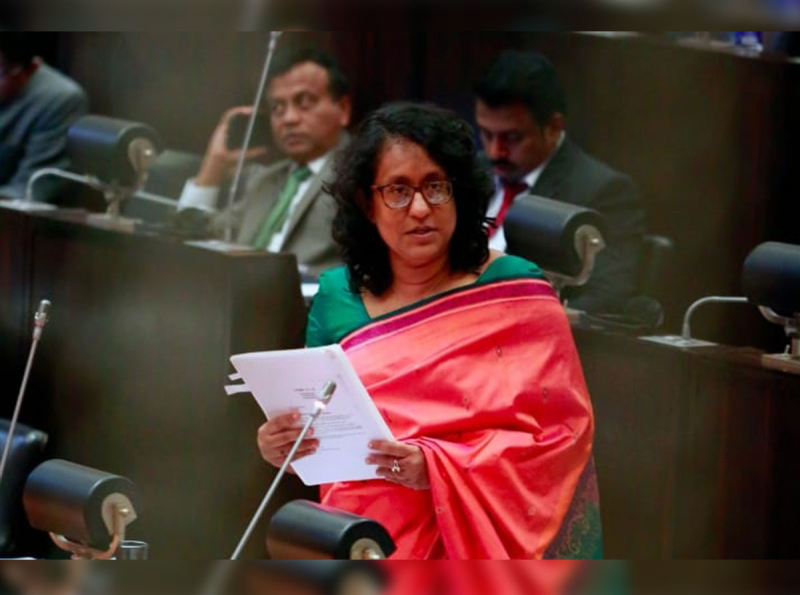-By Anubhavanananda

(Lanka-e-News -09.Aug.2025, 11.05 PM) Dr Harinie Amarasuriya, Sri Lanka’s Prime Minister, has long been regarded as a symbol of the country’s deepening education crisis. Her performance in Parliament last Wednesday (6th) confirmed that perception. While answering a question on the SupremeSat communications satellite — a venture linked to Rohitha Rajapaksa (nicknamed “Rocket Rohitha”) and his Supreme Global Holdings — Harinie presented figures so wildly inflated that they veered into the territory of the absurd, stitched together from a mixture of half-truths and outright falsehoods.
According to the Prime Minister, the 2011–12 period saw SupremeSat, a subsidiary of Supreme Global, enter into an agreement with the Board of Investment (BOI) on 23 May 2012. Between 2013 and 2014, she claimed, the company invested Rs 1,144,936,000 into the communications satellite project. She further explained that the project, covered under Section 17 of the BOI Act, involved establishing a satellite system at the Kandy Industrial Park with an investment of Rs 1,828 million, commencing commercial operations in August 2015. The ownership breakdown: Supreme Global Holdings (Pvt) Ltd with 80% and Supreme SL Investments (Pvt) Ltd with 20%.
She then tabled what she described as the company’s annual revenue from 2015 through to mid-2023. Her version read:
2015/16 – Rs 19,617 million
2016/17 – Rs 28,133 million
2017/18 – Rs 29,106 million
2018/19 – Rs 34,169 million
2019/20 – Rs 42,960 million
2020/21 – Rs 62,545 million
2021/22 – Rs 87,789 million
2023 (first six months) – Rs 39,590 million
The total, by her calculation, came to a staggering Rs 343,909 million — a sum that, as Cabinet colleague Wasantha Samarasinghe later pointed out, could only exist in the realm of fiction. Samarasinghe produced the actual revenue figures:
2015/16 – Rs 19.61 million
2016/17 – Rs 28.13 million
2017/18 – Rs 29.10 million
2018/19 – Rs 34.17 million
2019/20 – Rs 42.96 million
2020/21 – Rs 62.54 million
2021/22 – Rs 87.79 million
2023 (first six months) – Rs 39.59 million
The difference? Three missing decimal places, multiplying the figures a thousandfold. Supreme Media Network CEO Kanchana Kodituwakku, representing a subsidiary of SupremeSat, confirmed that the company had provided the government with correct data and could not be held responsible for how it was misrepresented in Parliament.
The arithmetic error, however, was not trivial. It laid bare what the writer calls a “crisis in basic numerical literacy” among Sri Lanka’s elite — even those holding doctorates. The decimal point, the difference between lakhs, crores, millions, and billions, remains a conceptual mystery to too many. Harinie’s figures would suggest that an obscure satellite services firm was generating revenues in excess of Rs 87 billion a year — a ludicrous proposition that any minister with common sense would have challenged before reading it into the Hansard.
Worse still, the question had been posed by D.V. Chanaka, a stalwart Rajapaksa loyalist from the SLPP. Chanaka does not, as a matter of political instinct, lob questions that might embarrass the Rajapaksa family. This was, in all likelihood, a carefully laid political trap, possibly orchestrated in collaboration with BOI insiders. Harinie walked straight into it.
A Prime Minister, the second citizen of the Republic, carries a responsibility far weightier than reading aloud whatever officials place in their file. Even junior civil servants are expected to read documents before signing them. The public does not need a head of government acting as a mere mouthpiece for unchecked statements.
The irony is that the controversy over Rohitha’s satellite project has a prior parliamentary history. When similar questions were put to Prof. Tissa Vitharana, then Minister of Science and Technology in the Rajapaksa government, he clarified that Sri Lanka had never launched a satellite — SupremeSat had simply contracted to use services from a Chinese satellite. The Rajapaksa-era claim that the country had put its own satellite into orbit was a political fantasy.
By failing to fact-check, Harinie not only reignited the dormant Rajapaksa loyalist base but, in the eyes of her critics, crowned herself their unwitting champion. The social media celebration among “Rajapaksa diehards” since her statement illustrates how a political adversary’s error can be weaponised for partisan revival.
This is not her first blunder. At a previous diplomatic event attended by the Chinese Ambassador, she referred to China as the “Republic of China” — the official name for Taiwan, Beijing’s arch-enemy — triggering unnecessary diplomatic tension. More recently, she was accused of naively endorsing education reforms traceable to the Rajapaksa era.
Dr Harinie Amarasuriya holds academic credentials few can challenge, yet her recent missteps suggest a deficit in political judgement and in the basic habit of interrogating information before repeating it. In the role of Education Minister, she must champion reforms that produce globally literate citizens capable of critical thinking — a standard she has, on this occasion, conspicuously failed to meet.
-By Anubhavanananda
---------------------------
by (2025-08-09 17:35:07)
Leave a Reply